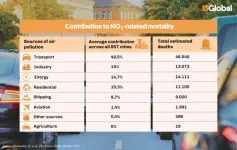(Press-News.org) Sophia Antipolis, 30 June 2023: Loneliness is a bigger risk factor for heart disease in patients with diabetes than diet, exercise, smoking and depression, according to research published today in European Heart Journal, a journal of the European Society of Cardiology (ESC).1
“The quality of social contact appears to be more important for heart health in people with diabetes than the number of engagements,” said study author Professor Lu Qi of Tulane University School of Public Health and Tropical Medicine, New Orleans, US. “We should not downplay the important of loneliness on physical and emotional health. I would encourage patients with diabetes who feel lonely to join a group or class and try to make friends with people who have shared interests.”
“Loneliness and social isolation are common in today's societies and have become a research focus during the last years, especially driven by the COVID-19 pandemic and the continuous digitalisation of society,”2 state Kahl et al. in an accompanying editorial. Loneliness refers to the quality of social contacts, while isolation refers to the quantity. They add: “The human species is inherently social by nature. Humans not only require the presence of others, but rely on meaningful social relationship[s] to develop into healthy adulthood. As individuals, we strive to belong to a family, a peer group, a community. These social interactions with family, friends, neighbours or colleagues are paramount for our physical and mental well-being.”
Patients with diabetes are at greater risk of cardiovascular disease and are more likely to be lonely than their healthy peers.3,4 Previous studies in the general population have found that loneliness and social isolation are both related to a higher likelihood of cardiovascular disease.5 This study in patients with diabetes examined whether patients who were lonely or socially isolated were more likely to develop cardiovascular disease than those who were not.
The study included 18,509 adults aged 37 to 73 years in the UK Biobank with diabetes but no cardiovascular disease at baseline.6 Loneliness and isolation were assessed with questionnaires, with high-risk features allocated one point each. High-risk loneliness feature were feeling lonely and never or almost never being able to confide in someone, for a total score of 0 to 2. High-risk social isolation factors were living alone, having friends and family visit less than once a month, and not participating in social activity at least once per week, for a total score of 0 to 3.
Some 61.1%, 29.6% and 9.3% participants had loneliness scores of 0, 1 or 2, respectively, while 44.9%, 41.9% and 13.2% had isolation scores of 0, 1 or >2, respectively. The researchers analysed the association between loneliness, isolation and incident cardiovascular disease after adjusting for factors that could influence the relationships including sex, age, deprivation, body mass index (BMI), medications, physical activity, diet, alcohol, smoking and control of blood sugar, blood pressure and cholesterol.
During an average follow-up of 10.7 years, 3,247 participants developed cardiovascular disease, of which 2,771 was coronary heart disease and 701 was stroke (some patients had both). Compared to participants with the lowest loneliness score, the risk of cardiovascular disease was 11% and 26% higher in those with scores of 1 or 2, respectively. Similar results were observed for coronary heart disease but the association with stroke was not significant. Social isolation scores were not significantly related to any of the cardiovascular outcomes.
The researchers also assessed the relative importance of loneliness, compared with other risk factors, on the incidence of cardiovascular disease. Loneliness showed a weaker influence than kidney function, cholesterol and BMI, but a stronger influence than depression, smoking, physical activity and diet.
Professor Qi said: “Loneliness ranked higher as a predisposing factor for cardiovascular disease than several lifestyle habits. We also found that for patients with diabetes, the consequence of physical risk factors (i.e. poorly controlled blood sugar, high blood pressure, high cholesterol, smoking and poor kidney function) was greater in those who were lonely compared to those who were not.”
He concluded: “The findings suggest that asking patients with diabetes about loneliness should become part of standard assessment, with referral of those affected to mental health services.”
ENDS
Authors: ESC Press Office
Tel: +33 (0)489 872 075
Email: press@escardio.org
Follow us on Twitter @ESCardioNews
Funding: The study was supported by grants from the National Heart, Lung, and Blood Institute (HL071981, HL034594, HL126024), and the National Institute of Diabetes and Digestive and Kidney Diseases (DK115679, DK091718, DK100383, DK078616).
Disclosures: The authors declare no conflicts of interest.
References and notes
1Wang X, Ma H, Li X, et al. Joint association of loneliness and traditional risk factor control and incident cardiovascular disease in diabetes patients. Eur Heart J. 2023. doi:10.1093/eurheartj/ehad306.
Link will go live on publication:
https://academic.oup.com/eurheartj/article-lookup/doi/10.1093/eurheartj/ehad306
2Kahl KG, Stapel B, Heitland I. A lonely heart is a broken heart: it is time for a biopsychosocial cardiovascular disease model. Eur Heart J. 2023. doi:10.1093/eurheartj/ehad310.
Link will go live on publication:
https://academic.oup.com/eurheartj/article-lookup/doi/10.1093/eurheartj/ehad310
3Shah AD, Langenberg C, Rapsomaniki E, et al. Type 2 diabetes and incidence of cardiovascular diseases: a cohort study in 1.9 million people. Lancet Diabetes Endocrinol. 2015;3:105–113.
4Petitte T, Mallow J, Barnes E, et al. A systematic review of loneliness and common chronic physical conditions in adults. Open Psychol J. 2015;8:113–132.
5Christiansen J, Lund R, Qualter P, et al. Loneliness, social isolation, and chronic disease outcomes. Ann Behav Med. 2021;55:203–215.
6UK Biobank is a large-scale biomedical database and research resource containing anonymised genetic, lifestyle and health information from half a million UK participants.
About the European Society of Cardiology
The European Society of Cardiology brings together health care professionals from more than 150 countries, working to advance cardiovascular medicine and help people lead longer, healthier lives.
About European Heart Journal
European Heart Journal (EHJ) is the flagship journal of the European Society of Cardiology. It is the world’s leading publication in general cardiology. Please acknowledge the journal as a source in any articles.
END
Loneliness linked with elevated risk of cardiovascular disease in patients with diabetes
2023-06-30
ELSE PRESS RELEASES FROM THIS DATE:
TGI-led research finds climate change, increasing population put Kenya at risk of famine
2023-06-30
ST. LOUIS - Research published in Outlook on Agriculture has shown that the population relative to available climate-suitable areas in Kenya has increased, posing a threat to the country’s economy and food security.
The study, “Spatial changes to climate suitability and availability of agropastoral farming systems across Kenya (1980-2020),” was published online on May 29.
The research team analyzed Kenya’s farming systems and climate zones between 1980-2020. Over that time, the population ...
Status of biobased production of succinic acid and derivatives
2023-06-30
The current status and future perspectives on the successful industrialization of biobased succinic acid are discussed in a comprehensive review article in the peer-reviewed journal Industrial Biotechnology. Click here to read the article now.
Succinic acid is one of the most important platform chemicals, with applications as a pharmaceutical ingredient, food additive, precursor of various chemicals, and raw material for biobased polymers. There is increasing demand for the sustainable production of succinic acid and its derivatives.
Sang Yup Lee, from the Korea Advanced Institute of Science and Technology (KAIST), and coauthors, review ...
Nearly half of tuberculosis cases in prisons worldwide go undetected
2023-06-30
In the first global assessment of TB among incarcerated people, a new study found consistently high TB case rates and low case detection in prisons, suggesting the need for health organizations to increase efforts to reduce the spread of TB among this high-risk population.
In 2019, incarcerated people across the globe developed tuberculosis (TB) at nearly 10 times the rate of people in the general population, according to a new study led by Boston University School of Public Health (BUSPH).
Published in The Lancet Public Health, the study found that 125,105 of the 11 million people incarcerated worldwide developed tuberculosis in 2019, ...
Non-invasive approach predicts retinopathy of prematurity earlier
2023-06-30
Research from Ann & Robert H. Lurie Children’s Hospital of Chicago promises to spare many premature infants from undergoing invasive eye exams to detect retinopathy of prematurity (ROP), the most common cause of preventable lifelong blindness in children in the U.S.
ROP is caused by an abnormal development of small blood vessels on the retina. Isabelle De Plaen, MD, and colleagues found that imaging the capillaries in the nailbed of preemies within the first month of life using a non-invasive technique, called nailbed capillaroscopy, can identify infants at high risk for developing ROP. This screening could eliminate the need to evaluate all premature infants with eye exams ...
Transport, domestic activities and agriculture are the main contributors to air pollution related mortality in European cities
2023-06-30
Air pollution is the largest environmental cause of death. Now, a study led by the Barcelona Institute for Global Health (ISGlobal), a centre supported by the "la Caixa" Foundation, has estimated which sources contribute most to the mortality associated with two air pollutants - PM2.5 and NO2 - in 857 European cities.
The results of this research, which have been published in The Lancet Public Health, show great variability between the different cities studied, suggesting that, given that each one has its own particularities and its own sources of air pollution, strategies to improve air quality should be adapted to each local context.
Contributors ...
Newly developed scoring system can correctly predict suicide risk after self harm
2023-06-30
A newly developed risk calculator that is based on 11 key social, demographic, and clinical factors, can correctly predict suicide risk in those who have self-harmed within the following 6 to 12 months, suggests research published in the open access journal BMJ Mental Health.
Pending further validation, OxSATS, short for Oxford Suicide Assessment Tool for Self-harm, may help inform treatment decisions and the most effective targeting of resources, suggest the researchers.
Self-harm is associated with a heightened risk of suicide within the following 12 months that ...
Lessons learned from first genetically-modified pig heart into human patient
2023-06-30
B-roll video and interview with researcher
BALTIMORE, June 29, 2023– A new study published today in The Lancet has revealed the most extensive analysis to date on what led to the eventual heart failure in the world's first successful transplant of a genetically-modified pig heart into a human patient. This groundbreaking procedure was conducted by University of Maryland School of Medicine (UMSOM) physician-scientists back in January 2022 and marked an important milestone for medical science.
The patient, 57-year-old David Bennett, Sr., was treated at the University of Maryland ...
Higher levels of lean muscle might protect against Alzheimer’s disease
2023-06-30
High levels of lean muscle might protect against Alzheimer’s disease, suggests a large study published in the open access journal BMJ Medicine. But further research is needed to tease out the underlying biological pathways, along with the clinical and public health implications, say the study authors.
Obesity has been associated with a heightened risk of Alzheimer’s disease in numerous studies, possibly explained by the attendant increased inflammation, insulin resistance, and higher levels in fat tissue of the protein harmful to brain health, amyloid β.
Lower levels of lean muscle have also been associated with a heightened risk of the disease, but it’s ...
1.3 million disabled workers trapped in insecure work in UK – and 430,000 want to work more hours
2023-06-30
Disabled workers are 1.5 times more likely than non-disabled to be in severely insecure work
Disabled women are more than twice as likely to be in severely insecure work than disabled men
Autistic workers (38%) and those with mental health conditions (28%) are most likely to be severely insecure work
New research by the Work Foundation at Lancaster University reveals 1.3 million* disabled workers are trapped in severely insecure work in the UK – and 430,000 say they want to work more hours.
Disabled workers are 1.5 times ...
Consumers more likely to use virtual apparel try-on software if interactive
2023-06-30
While more and more people are shopping online, purchasing clothes on the internet poses a unique challenge: What if it doesn’t fit? The apparel industry’s latest solution is virtual try-on sessions that allow consumers to share photos or measurements of themselves to create a similar-sized avatar.
While some consumers have significant concerns about the new technology, especially young people, new research from the University of Missouri found that qualities such as the perceived ease of using the technology significantly ...



